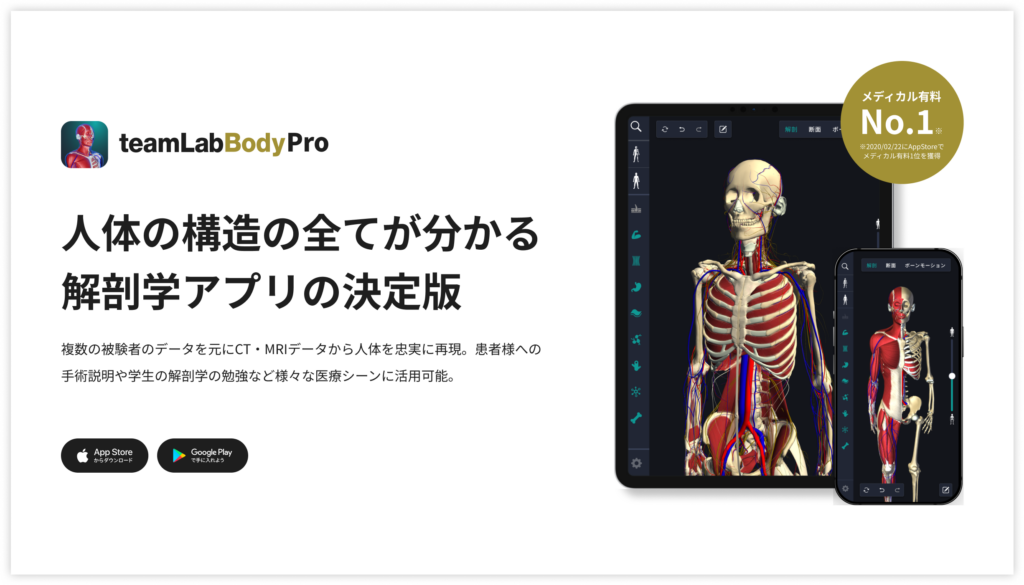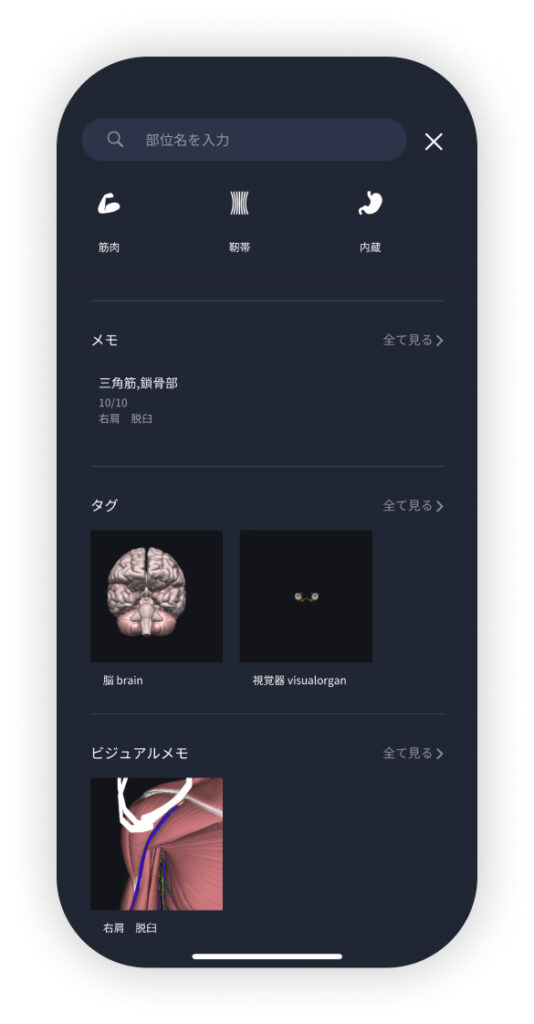beginning
In this article, I will explain effective study methods, starting with knowledge of specialized parts in human anatomy.
In human anatomy, it is necessary not only to memorize the names of various organs, muscles, and bones, but also to remember where they are located in the body. Therefore, it is necessary to learn as efficiently as possible.
I hope you will deepen your understanding even a little by reading this article and using the app.
Now, I'll explain the details about “pulleys” and how to study human anatomy.
teamLab Body Pro Free Download
A 3D anatomy app that shows all the structures of the human body
Download teamLab Body Pro here!

What is a pulley?
The anatomy application allows you to view a selection of anatomy 3D models. In this model, there are various observation methods such as surfaces, cross-sections, and nervous systems. This time, I'll explain using an anatomy application.
About pulleys

A pulley (Trochlea)Anatomical structures that are particularly important in ophthalmologyIt indicates a pulley-like structure through which superior oblique muscles (superior oblique muscles) involved in eye movement pass. Specifically, it is located in the upper medial part of the frontal bone and forms a fibrous ring-shaped structure.
The superior oblique muscle passes through this pulley, changes direction, and runs backwards from the top and outside of the eyeball. Due to this structure, the superior oblique muscle enables the eyeball to rotate downward and outward (downward/external rotation).
The relationship between the pulley and the superior oblique muscle is essential for understanding eye movements, especially external ophthalmoplegiatrochlear nerve (IV cranial nerve) palsyIt is deeply related to such pathologies.
When the trochlear nerve is damaged, double vision (especially when viewing downward) and abnormal eye movements occur, which are clinically important findings. Therefore, accurately understanding the location and function of pulleys is very important not only for anatomical knowledge, but also for clinical applications.
Study points
Anatomical understanding: understanding relationships between structure and surroundings
The pulley is a small fibrous structure located inside the frontal bone and acts as a “pulley” that changes the running of the superior oblique muscle. It is a small structure that is often overlooked from an anatomical point of view, but it is very important for understanding eye movements. If you learn using an anatomical diagram or 3D model showing the starting and stopping part of the superior oblique muscle that runs from a pulley, and the direction of its movement, you can visually grasp the relationship between muscle and structure.
Also, don't forget that the trochlear nerve (IV cranial nerve) is distributed in this muscle. Three-dimensional imaging of the connection between pulley, nerves, and muscles leads to a deeper understanding.
Functional understanding: thinking in conjunction with eye movements
The superior oblique muscle that passes through the pulley is the eyeballMove downward and outwardIt takes on a role. This movement is necessary for line of sight movement when reading a book or descending stairs, for example. In learning, you can actually check eye movements with a mirror and experience which muscles are used when moving in which direction by moving one eye at a time.
In particular, when the trochlear nerve is impaired, double vision (double seeing objects) and compensatory postures in which the person tilts the head to correct gaze appear, so it is effective to learn the relationship between dysfunction and movement.
Practical application: learning in connection with clinical conditions
Pulley learning also has high clinical significance due to its relationship with the nervous system. In particulartrochlear nerve palsyIt can be seen in a wide range of fields such as ophthalmology, neurology, and orthopedics. When this paralysis occurs, it becomes difficult for the eyeballs to lower, and patients can correct their gazeTilt your head to a healthy sideThere are times when I take that kind of attitude.
In order to understand these compensatory actions and symptoms, it is necessary to grasp not only the simple structure, but also the surrounding anatomical background (superior orbital fissure, cavernous sinus, positional relationship with optic nerve, etc.). Learning from this perspective before entering clinical practice is the key to developing practical skills.
How to study human anatomy
I will explain specific study methods using human anatomy applications.
Check your past learning history and practice repeatedly
Here are the steps to check your anatomy learning history and practice iteratively effectively.
1. Check your learning history in the app
Reviewing your learning history with the application is an important step in effectively advancing anatomy learning. First, launch the app and go to the learning history section from the main menu. Many anatomy apps are designed to show your progress in the form of graphs and lists, so you can visually check which parts you've learned about and how much time you've spent.
By using this data, you can understand which areas you have strengths in and where you need to spend more time and effort. We also recommend using a dedicated tag or notebook function to mark areas you are particularly weak at or where you need to relearn. Regularly checking your learning history and looking back on past learning content will lead to efficient review and deepening understanding.
2.Make a plan for iterative learning
Making an efficient repetitive learning plan based on learning history is extremely effective in promoting knowledge retention. First, identify weak points and areas where you need to relearn. Next, arrange these study items into a weekly or monthly calendar and create a specific study schedule. By proceeding in a planned manner, you can learn each part evenly and avoid packing in a large amount of information at once.
Using a task management app or digital calendar to set study reminders is effective. Also, it's important to have the flexibility to regularly review progress and revise plans as needed. By having goals and proceeding with your studies in a planned manner, you can efficiently acquire anatomical knowledge.
3.Use 3D features to learn visually
By utilizing the 3D function, learning anatomy is easier to understand visually. The 3D model shows the structure of the human body three-dimensionally, and each part can be observed in detail. This makes it possible to intuitively grasp positional relationships between deep muscles and organs that are difficult to capture in a planar view. For example, you can learn even the smallest details by rotating specific muscles and bones and zooming in and out.
Also, there are many apps that have the function of displaying cross-sectional views of each part using a 3D model, which is useful for deepening understanding of internal structures. This diversity of visual information helps with memory retention and improves immediate responsiveness in tests and practice situations. By utilizing the 3D function and learning visually, you can learn anatomy knowledge more deeply and efficiently.
Use the memo function concretely

Make notes so you don't forget the things and points you've noticed while studying. The memo function can be used for different purposes, such as inputting text, saving images, and writing memos. Tag your notes to make them easier to review later.
Test your learning regularly in the form of quizzes
Regularly testing what you've learned in a quiz format is a very effective way to anchor your anatomy knowledge. Quiz-style tests help you objectively grasp your level of understanding and areas you lack while repeating knowledge.
For example, by using a learning app to conduct quizzes every specific period, you can reconfirm what you've learned and strengthen your memory. There are a wide range of quiz formats, such as multiple choice questions, fill-in-the-blank questions, and short answer questions, and each helps understanding from a different angle and develops the ability to utilize various types of knowledge.
Get feedback
If possible, get feedback from other learners and experts. It helps you find your own gaps in understanding and areas for improvement. You can also keep yourself motivated to learn by regularly testing yourself. Feeling a sense of accomplishment and progress increases motivation for continuous learning.
summary
This time, I explained how to study “pulleys” using an application!
Thank you for reading this far.
I would be happy if reading this article helped you learn about anatomy.
Learning is a long, never-ending journey, but I sincerely wish you all the best. Let's continue to study together and work hard for the national exam!
Please look forward to the next blog.
teamLab Body Pro Free Download
A 3D anatomy app that shows all the structures of the human body
Download teamLab Body Pro here!





